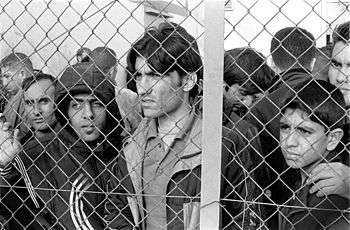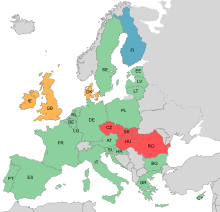Asylum in the European Union

Asylum in the European Union (EU) has its roots in the 1951 Convention Relating to the Status of Refugees,[1] an agreement founded on Article 14 of the Universal Declaration of Human Rights.[2] Following the adoption of the Schengen Agreement on the elimination of internal border controls of signatory states and its subsequent incorporation into the EU legislative framework by the Amsterdam Treaty,[3] the EU set up a Common European Asylum System (CEAS) to unify minimum standards related to asylum, leaving up to EU Member States the discretion to establish procedures for obtaining and withdrawing international protection.[4]
Relevant law and procedures
The EU set the objective of introducing "appropriate measures"[5] with respect to asylum in the Amsterdam Treaty, which required the Council of the European Union to adopt measures on asylum in accordance with the Geneva Convention and the Protocol Relating to the Status of Refugees[6] by 2004, five years after the Treaty of Amsterdam entered into force.
The current legal bases for the EU's creation of a harmonised legislative framework on asylum are found in the Treaty on the Functioning of the European Union[7] and the EU Charter of Fundamental Rights.[8]
Refugees entering Europe are subject to follow the laws in place by the Common European Asylum System (CEAS). These laws were reformed between 2011 and 2014, and have not since been updated due to the current state of the refugee crisis[9]. The crisis is of an emergency state, so the main priority has been exercising asylum laws, rather than the reformation of them. These laws are in place to prohibit European Union Member States from sending an individual back to where they are at risk of persecution, and to offer international protection to those who are granted refugee status through the course of the law. Upon arrival in an EU Member State, individuals and families seeking refugee status are subjected to a comprehensive assessment of their life in their country of origin. The CEAS is tasked with assessing if an individual is truly eligible for refugee status, or if, for example, they are an economic migrant. If, through this process, an individual is deemed a refugee, they are subsequently granted international protection. For this status and protection to be granted, the potential danger and harm that could follow suit after a person's return to one's country of origin must be established. If Member States do not find this to be true of an individual's conditions, they are mandated under the CEAS to return said individual to the country he/she originated, as they have therefore been deemed an "illegal economic migrant". However, due to the lack of paperwork or documentation, it is often difficult for EU Member States to actually execute this mandate, and some "illegal economic migrants" manage to continue their journey through the EU after successful evasion.
Outsourcing asylum
The outsourcing of asylum is a type of migration policy pursued by the countries of the European Union, it consists of relocating the reception and accommodation of asylum seekers and the processing of their asylum applications, in places near the borders of the EU or in countries outside the EU, from which asylum seekers originate or through which they pass. After an attempted relocation of asylum procedures in centres on the boundaries of the EU, in 2003 these policies have resulted in a proliferation of exile camps in and around the European Union, a pressure on neighbouring countries to develop systems that consider applications for asylum in their territories, and a radicalisation of antimigratory policies in neighbouring countries and within the border of the European Union.[10]
Asylum shopping
In the jargon of European institutions, asylum shopping is the practice of refugees wanting to choose a country other than that prescribed by the regulations to apply for political asylum, to choose the one which will offer the best reception conditions, or to lodge an application in another country after being dismissed. This expression is used to treat certain asylum seekers in analogy with consumers of welfare provisions[11]). Such definition appears in official documents, newspaper articles, analysis, etc. Asylum shopping is practised by 12% of asylum seekers, according to former European Commissioner for Justice Franco Frattini.[12]
Differences between Member States

The differences between the laws of different Member States are the main cause of the desire of refugees to choose their host country; in fact some states give refugee status to the majority of applicants, while others give it to less than 1%. The Dublin Regulation enables a state to return an asylum seeker in the first Member State where he or she transited (so-called readmission). This provision was put to put pressure on border states, so that they exercise better control on the external borders of the EU. The effect of this measure is that a greater number of asylum applications in the border states (like Greece, Slovakia, Poland or Malta) and in some cases, the expulsion of asylum applicants in neighbouring countries such as Ukraine,[13] Turkey or Russia where the system of recognition of refugee status is often faulty. The UNHCR asked the European Union in 2008 to not return Iraqi asylum seekers to Greece.[14] In 2017 Maria Teresa Rivera became the first woman in the world granted asylum because of being wrongly jailed for disregarding a ban on abortion; she disregarded the ban in El Salvador and was given asylum in Sweden.[15]
Land mark ruling of the European Court of Justice upheld the right of member states to return asylum seekers who crossed the EU external border to the member state in which they first arrived ‘irregularly’ (A.S. (European Union - Immigration - Asylum : Opinion) [2017] EUECJ C-490/16_O (8 July 2017)).
Number of accepted asylum applications in 2012[16]
| Country | Total number | Per 100,000 inhabitants |
|---|---|---|
| Germany | 22,165 | 27 |
| Sweden | 15,290 | 161 |
| United Kingdom | 14,570 | 23 |
| France | 14,325 | 22 |
| Italy | 9,270 | 15 |
| Norway[17] | 6,125 | 123 |
| Austria | 6,000 | 71 |
| Netherlands | 5,920 | 35 |
| Belgium | 5,880 | 53 |
| Switzerland | 4,580 | 58 |
| Denmark | 2,105 | 38 |
| Finland | 1,840 | 34 |
| Malta | 625 | 348 |
| Greece | 625 | 1 |
| Spain | 565 | 1 |
Restrictive Legislation
Ostensibly to fight against fraud, most European states have engaged in restrictive policies, like the United Kingdom (UK Borders Act 2007, etc..), The Netherlands, which has passed the Aliens Act in April 2001, Italy, with the Bossi-Fini Act of July 2002, or France, with different Acts (French Law of 24 July 2006 on immigration and integration, and French Law of 20 November 2007 on the control of immigration, integration and asylum). These measures have reduced the number of asylum seekers that are awarded the status of Refugee.[18]
As part of the adoption on first reading of four codecision acts, between 4 and 7 May 2009, MEPs voted on 7 the asylum package.[19] This includes a proposed revision of the "reception" directive and another proposal to improve the Dublin system. The Commission also proposes to revise the regulations Eurodac (biometric database) and create a European Asylum Support Office, partially financed by funds previously granted to the European Refugee Fund, which will be responsible for assisting Member States in the management of asylum applications. Chachipe a Roma rights organisation has criticised EU asylum policy that denies Roma from the former Yugoslavia asylum based on the "safe country of origin"[20] doctrine, as they face discrimination in their home countries.[21]
12 EU countries already have national lists of safe countries of origin.
See also
References
- ↑ "Common European Asylum System". European Commission.
- ↑ "United Nations General Assembly resolution 429(V) of 14 December 1950". United Nations.
- ↑ "Summaries of EU legislation: The Schengen area and cooperation". The Publications Office of the European Union.
- ↑ "Reforming the Common European Asylum System: Frequently asked questions". European Commission.
- ↑ "Article 2, p. 152, Consolidated version of the Treaty on European Union". Official Journal of the European Communities, C 340, 10 November 1997.
- ↑ "Article 63, p. 202, Consolidated version of the Treaty on European Union". Official Journal of the European Communities, C 340, 10 November 1997.
- ↑ "Articles 67(2) and 78, Consolidated version of the Treaty on the Functioning of the European Union". Official Journal C 326 , 26 October 2012 P. 0001 – 0390.
- ↑ "Article 18, Charter of Fundamental Rights of the European Union". Official Journal C 326, 26 October 2012, p. 391–407.
- ↑ "Refugee Law and Policy: European Union". Law Library of Congress. June 2016.
- ↑ VALLUY Jerome Rejection of exiles – The great reversal of the right of asylum, 2009
- ↑ ldeucom/84/8407.htm # n35 Select Committee on European Union Tenth Report,House of Lords
- ↑ 2144,2579627,00.html Article by Deutsche Welle
- ↑ According to Amnesty International, Ukraine is not a safe country for asylum: The UNHCR also asks not to return asylum seekers to Ukraine
- ↑ The Independent, London, 17 June 2008
- ↑ Moloney, Anastasia. "Sweden welcomes Salvadoran woman wrongly jailed for abortion in asylum first". Reuters. Retrieved 2017-04-05.
- ↑ Mona W. Claussen (27 November 2013) Slik håndterer Europa asylstrømmen Aftenposten based on numbers from Eurostat. Retrieved 5 December 2013
- ↑ Norway is not a member of the EU, but part of the Dublin Agreement
- ↑ French documentation,Asylum in the European Union
- ↑ Asylum policy: Parliament wants to introduce new rules, press release of the European Parliament, 7 May 2009
- ↑ "Glossary". European Migration Network. Retrieved 14 April 2013.
- ↑ "Veranstaltung mit frau Dr. Phil. Karin Waringo vom Romaverband Chachipe E. V., Luxembourg". Amnesty International, Konstanz division (in German). 15 December 2012. Retrieved 14 April 2013.